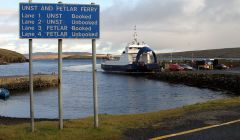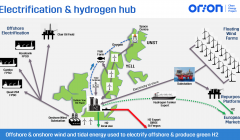Letters / Wind farms, hydrogen, ferries – Shetland need to watch that others don’t ‘cream off’ its future
With apologies to the author of the Ancient Mariner ‘water, water everywhere nor any drop to drink’, but by omitting the oxygen portion of H₂O it becomes ‘hydrogen, hydrogen everywhere enough to make you think?’
Will the potage be drinkable within Shetland without acceptable controls?
Aker to the north, Orion to the east, Cerulean to the west, and Viking muddling in the middle. Who are the stakeholders/financiers of the three offshore and onshore hydrogen propositions?
In the ST of 5th November one of the questions asked by a senior fisherman was “what are the costs of maintaining windmills over their lifetime” and also what will be the effect on the fishing industry by exclusion from these maritime areas which have sustained the island’s economy over several centuries? Is there a fisherman presently serving on the SIC who can bring these concerns to the council’s table more formally, forcibly and reach the attention of a wider local and national audience?
If not, the opportunity exists for one or more fisherfolks to be elected to the SIC next year. Would candidates please step forward. New blood is required as per Mr Vic Thomas’ recent letter to the Shetland News.
Shetlanders are not Luddites denying all “progress” but need to see that any benefits are shared, with the Zetland County Council Act 1974 and the Sullom Voe Terminal agreements being cases in point, with the Oil Fund. It behoves the SIC to negotiate a similar but greatly improved disturbance and beneficial financial deal with these groups.
Presentations and schematics at COP26, also mentioned in the ST of 12th November for the proposed hydrogen plant at Sullom also include an export possibility of hydrogen and ammonia by gas tanker which is of interest to me since I have been involved with those types of vessels since 1966 in one way or another until I retired.
Become a member of Shetland News
Up to the present time the coldest cargoes carried by sea have been in LNG carriers down to -160C, the boiling point of methane, but the boiling point of hydrogen is -259C; quite a quantum leap for application to a marine environment with specialist metals required.
Liquid hydrogen is already widely used and transported throughout the USA by specialised trucks and is as safe to handle as other products such as LPG and petrol, which is also evidenced by its widespread use in Iceland.
With that to mind, I note that Kawasaki Shipyards have recently built an innovative vessel called the Suiso Frontier to carry 1,250m³ of liquid hydrogen(equal to one million m³ of gas) in tanks with a double skin, presumably to take advantage of an extremely cold vacuum between them, together with reefer units used on the trucks in the USA. Cryogenic tanks have also been constructed for the hydrogen trade from Australia using coal as the feedstock to Kobe Japan.
I think that the lead time to design, construct and deploy these new specialist types of vessels for any export trade from Shetland might be well over ten years. Ammonia, or one nitrogen plus 3 hydrogens is carried at a boiling point of -33C which most LPG type vessels can accommodate and is used mainly as agricultural fertilizer.
However, there is concern that the run-off of nitrates, from nitrogen, has been polluting rivers, so perhaps that trade is not the one which might be pursued. Have I missed a point with the destination for the ammonia? The substance carries three hydrogens attached to one nitrogen. It could be a less expensive and practical method of transporting (at -33C) those hydrogen energy molecules to an ammonia receiving terminal where the hydrogens could be split and fed into a gas grid releasing the nitrogen molecule into the atmosphere, which already contains 78 per cent nitrogen, as opposed to transporting hydrogen as a liquid at much lower temperatures.
The plan also depicts a vessel for liquid CO², carbon dioxide, at a boiling point of -78C, or perhaps -50C at a pressure of about five bars, as an import to Sullom – but from where, and for what reason?
Will it be used at the hydrogen plant in a steam re-former with methane (ie CH4 or natural gas) to free up hydrogen to use in a Haber Bosch process to produce ammonia. If so, the natural gas/methane stream has to come from one of the existing streams, such as Total, entering Shetland.
To accommodate the export of hydrogen by ship, cryogenic tanks and equipment would have to be built at/close by the Sullom Voe Terminal. To export energy from Shetland via liquid hydrogen, modifications would have to be made to the jetty pipelines and chicksans. Similarly, an ammonia storage tank with associated pipework/chiksan arms would also have to be constructed.
The SIC, as planning and harbour authorities, should play their cards correctly in any negotiations to the benefit of all in Shetland. Indeed, isn’t Shetland the owner of all the land at, and around the Sullom Voe Terminal? Perhaps urea could be produced for local agriculture?
An economic supply of electricity and hydrogen to the population to support existing and nascent industries would be beneficial and indeed essential.
Ammonia as anyone familiar with it will confirm is a highly noxious material and an irritant, and any release to the atmosphere highly undesirable. Several schemes are being considered to use it as fuel for ships’ engines and possibly in jet engines, and indeed it was used in Belgium during the war to power buses.
It should be noted that in the 1970s, a small Sullom Voe Terminal participant company proposed an LPG plant at Sullom for local propane and butane consumption. They failed mainly because two big oil companies with the largest entitlement had by pre-exemption already sold their LPG under a long term contract before the establishment of BNOC, to prevent it/government, and hence the proposer, getting hands on that share of the production.
The lesson to be learned is that all contracts associated with the hydrogen projects, including shipping, should be open to public scrutiny and agreement before signature. As an equity partner, Shetland would be able to do so.
And so to internal ferries: Recently, hydrogen via battery/fuel cells/or generators has been used to power small ferries in Orkney. Perhaps the latest get-out to be used by the Scottish/UK Governments to refute and deny fixed links is that hydrogen could be used.
However, to retrofit hydrogen, either as compressed gas or in a fuel cell or battery system, to the existing but rapidly ageing ferry fleet, is unacceptable for many technical and social reasons.
Furthermore, designing, ordering and taking delivery of new hydrogen type powered replacements will take time – you only have to refer to the fiasco at Ferguson Marine – perhaps 20 years or more including the training of local crews in a new technology system.
The previous rejection of tunnels was based on the lifetime costs of new ferries over sixty years compared to fixed links. What utter tosh, and the SIC believed that and paid a consultant good money to be so deceived. What a disgraceful report and what a waste.
Do not let that happen this time. Recently, it was reported in the ST, that 50 years ago, Bressay residents wanted a tunnel as soon as possible as they had seen the benefits of the recently completed Trondra and Burra bridges. Folk in Whalsay, Yell, Unst, Bressay, Papa, and Fetlar should expect and deserve nothing less.
The solution? Replace the ferries by the UK Government through direct financing and building fixed links now. These should all be completed before hydrogen and ammonia from the refinery becomes available, and with the bonus that there will be no CO² emitted from the replaced ferries.
Indeed, with the government’s anticipated tax take from the hydrogen refinery project, the financing of fixed links will just be a very small amount of change to the UK Chancellor. A no brainer – everyone wins.
Shetland is in a very fortunate position to take part in and take advantage of the new burgeoning hydrogen based economy, which is destined to become worldwide, but should take care that others based in Edinburgh, Westminster or “The City”, do not cream off its inheritance or its future.
Cecil Robertson
Inverness
Become a member of Shetland News
Shetland News is asking its readers to consider paying for membership to get additional perks:
- Removal of third-party ads;
- Bookmark posts to read later;
- Exclusive curated weekly newsletter;
- Hide membership messages;
- Comments open for discussion.
If you appreciate what we do and feel strongly about impartial local journalism, then please become a member of Shetland News by either making a single payment, or setting up a monthly, quarterly or yearly subscription.














































































